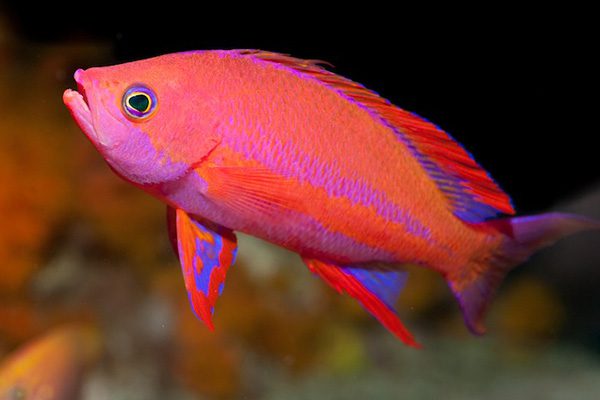The Reef’s Constant Pulse: Ecology & Dynamics of Anthias (Pseudanthias squamipinnis) in Marsa Alam
The coral reefs of Marsa Alam are bustling cities beneath the waves, and if the hard corals are the buildings, then the Anthias (Pseudanthias squamipinnis) are the vibrant, ceaselessly moving inhabitants that bring the entire metropolis to life. Far more than just beautiful decorations, these ubiquitous fish represent the very pulse of the reef, a critical link in the energy flow and a fascinating example of complex social dynamics in the marine world. Sambo Divers Marsa Alam invites you to dive deeper into understanding the vital ecology and intricate lives of these mesmerizing creatures, uncovering the true engine behind the Red Sea’s vibrant ecosystems.
Life in the Water Column: The Ecology of Pseudanthias squamipinnis
Anthias are small, agile fish exquisitely adapted to their life hovering above the coral:
- Primary Planktivores: Their most crucial ecological role is as planktivores. They are voracious eaters of zooplankton (tiny crustaceans, larval fish, and other microscopic organisms) that drift in the water column. By consuming vast quantities of plankton, Anthias effectively convert pelagic energy from the open ocean into biomass on the reef, making it available for larger predators. This makes them a fundamental part of the reef’s food web.
- Energy Conversion Hub: Their constant feeding means they are always taking in energy, which then fuels the larger predators who prey on them. Without Anthias, a significant amount of planktonic energy would simply drift past the reef, demonstrating their vital role as an energy transfer hub.
- Safety in Proximity: Their dense schooling directly above the reef provides collective protection. While individual Anthias are small and vulnerable, the sheer number and the synchronized, evasive movements of the school make it incredibly difficult for predators to single out a target. Their immediate proximity to the complex coral structure allows for instant retreat into safety when threatened.
A Fascinating Social Structure: Protogynous Hermaphroditism
One of the most intriguing aspects of Pseudanthias squamipinnis ecology is their unique social system:
- Protogynous Hermaphroditism: Anthias are protogynous hermaphrodites, meaning all individuals are born female. Within a typical school, there is usually one dominant male, easily identifiable by his larger size and more vibrant coloration, who presides over a harem of numerous females.
- Sex Change (When Needed): If the dominant male dies, disappears, or is removed from the school, the largest, most dominant female will undergo a remarkable transformation. Within a matter of weeks, she will change sex, developing male gonads and acquiring the characteristic male coloration and elongated dorsal fin ray. This ensures the continuation of the harem’s social structure and reproductive success, demonstrating incredible adaptive plasticity.
- Haremic System: This creates a stable social hierarchy, with the male controlling breeding access to his females. The constant darting and displays seen among males are often related to defending their territory and maintaining their position within the social order.
Threats and Conservation in Marsa Alam’s Reefs
While Anthias are abundant in healthy reefs, their well-being is intrinsically linked to the health of their coral habitat:
- Coral Health Dependence: As they rely on coral for shelter from predators, mass coral bleaching events or physical destruction of coral reefs directly impacts Anthias populations. Without the intricate refuge of the coral branches, their vulnerability to predation increases dramatically.
- Water Quality: Their reliance on plankton means that changes in water quality that affect plankton populations (e.g., pollution, nutrient imbalances) can also impact their food source.
- Not a Fishing Target: Fortunately, Anthias are generally not a target for commercial fishing, which provides them some protection compared to other reef fish. However, the indirect effects of human activity on their habitat remain a concern.
Sambo Divers Marsa Alam: Ambassadors for Reef Health
The Anthias (Pseudanthias squamipinnis) in Marsa Alam represent the pulsating vitality and intricate balance of the Red Sea’s coral reefs. Sambo Divers Marsa Alam is committed to fostering a deeper understanding and appreciation for these essential creatures:
- Promoting Respectful Observation: Our dive guides ensure divers observe these magnificent schools without causing stress, maintaining appropriate distance and buoyancy.
- Educating on Reef Ecology: We highlight the critical role Anthias play as planktivores and their fascinating social structures, connecting divers to the broader ecological picture.
- Advocating for Coral Conservation: By emphasizing the direct link between healthy coral and thriving Anthias populations, we reinforce the importance of protecting the entire reef ecosystem.
To witness the endless, vibrant dance of Anthias (Pseudanthias squamipinnis) in Marsa Alam is to see the very lifeblood of the Red Sea’s coral reefs. Join Sambo Divers Marsa Alam for an enriching dive experience, where you can safely marvel at these living jewels and become a part of the effort to preserve the magic of our underwater world.




0 Comment